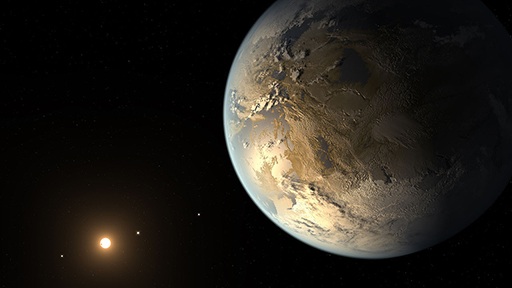7 Kepler’s small planets
The ‘holy grail’ in the early years of exoplanet discovery was a rocky planet located in the habitable zone of its star. Remember, the first exoplanets to be discovered were the much more easily detectable ‘hot Jupiters’ – too large to be rocky and too close to their star for liquid water to exist.
But as more technology, like Kepler, was applied to exoplanet research the size of planets being discovered rapidly decreased. Scientists expect planets that have a chance of hosting life to be rocky, so the small planets discovered by Kepler are especially important for the Drake equation.
The planets found so far by Kepler and other planet searches tell us that rocky planets are common companions of M-type stars – the smallest, coolest type of main sequence star. These are often referred to as red dwarf or M dwarf stars. These stars are very common – much more common than bigger, more luminous stars like the Sun. In fact, about 70 to 80 per cent of the stars in the Galaxy are M dwarf stars.
Because they are relatively very dim, the habitable zone lies very close to M dwarf stars, closer than Mercury is to the Sun. Studies of the Kepler data indicate that there could be at least one Earth-sized, potentially habitable, planet for every six M dwarf stars in the Milky Way. That could work out at around 50 billion!
So, we now know our Galaxy must be swarming with small planets in the habitable zones of small stars. There are plenty of small stars in our immediate neighbourhood – in fact, there are 50 within 15 light years from us. This means we could expect to have eight or more very close Earth-sized planets that are potentially habitable. By ‘close’, here, we mean in the context of the size of our Galaxy: a planet 15 light years away is not close in our everyday sense!
Kepler found hundreds of Earth-sized planets, some of which might be in the habitable zones of their stars. The first one of these, announced in 2014, was Kepler-186 f – the fifth planet in the Kepler-186 system. The star, Kepler-186, is about half the size of the Sun, so it is cooler. Kepler-186 f takes around 130 days to orbit its star, so its discovery required analysis of three years of observations.
However, we may never know whether Kepler-186 f and many of the other small Kepler planets are really habitable. We may not even know if they’re really rocky. Unfortunately, their host stars are too faint and far away from us. The planets are not big enough for us to measure their masses using the radial velocity technique: the signals would simply be too small. It will also be very difficult to study other properties of these planets in more detail.

